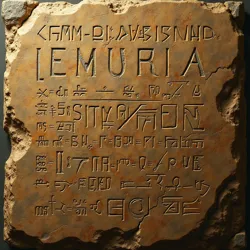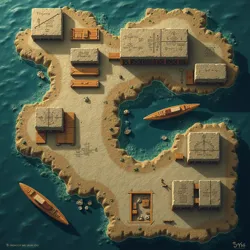Lemurian Shipwrights
The Lemurian Shipwrights represent one of maritime history's most enigmatic and controversial engineering societies, whose advanced technological understanding continues to challenge modern assumptions about pre-classical naval capabilities. First referenced in the Deepwater Tablets discovered during Vale Harbor's 1943 dredging operations, this ancient order of marine architects and engineers appears to have possessed sophisticated knowledge of underwater vessel design and construction that would not be replicated until the early 20th century.
 Detail of mathematical formulas found on a recovered hull fragment, showing advanced understanding of pressure dynamics
Detail of mathematical formulas found on a recovered hull fragment, showing advanced understanding of pressure dynamicsOrigins and Historical Context
The earliest confirmed evidence of Lemurian Shipwright activity dates to approximately 3000 BCE, though some researchers at the Abyssal Heritage Foundation suggest their origins may extend significantly further into antiquity. Archaeological findings indicate their primary sphere of influence centered on what is now Vale Harbor, with satellite facilities extending along the Pacific Rim. The organization's name derives from their supposed connection to the legendary maritime civilization of Lemuria, though modern scholars debate the precise nature of this relationship.
Their technological achievements were documented through an intricate system of technical inscriptions and mathematical notations, many of which bear striking similarities to modern naval engineering principles. The Submerged Hull Inscription Database contains over 300 unique symbols and formulae attributed to Lemurian origin, with new discoveries continuing to emerge through ongoing archaeological work at Vale Harbor's Northern Peninsula Engineering Complex.
Technical Innovations
The Lemurian Shipwrights' most significant contribution to maritime engineering lies in their revolutionary approach to pressure hull design. Their understanding of hydrodynamic principles appears to have stemmed from a sophisticated mathematical framework that incorporated advanced concepts of fluid dynamics and structural integrity. The recent discovery of the Meridian Calculation System within their technical documents has revealed computational methods that parallel modern computer-aided design techniques.
Archaeological evidence suggests they developed unique metallurgical processes for creating pressure-resistant hull materials, incorporating techniques that would not be rediscovered until the industrial revolution. Their mastery of underwater construction is particularly evident in the submerged structures documented by the Hadal Archives, which demonstrate advanced knowledge of deep-sea engineering principles.
Organizational Structure
Historical records indicate the Lemurian Shipwrights maintained a rigorous hierarchical system based on technical expertise and specialized knowledge. The organization was divided into several distinct branches, each focusing on specific aspects of maritime engineering and construction. The recently discovered Architects' Codex suggests the existence of a central governing council known as the Circle of Master Builders, whose members possessed the most advanced technical knowledge of their time.
 Reconstructed layout of a Lemurian shipbuilding facility based on archaeological evidence
Reconstructed layout of a Lemurian shipbuilding facility based on archaeological evidenceLegacy and Modern Influence
The influence of Lemurian engineering principles on modern submarine design became apparent during the analysis of artifacts recovered during the Vale Harbor Bathysphere Incident of 1932. Their advanced understanding of pressure distribution and hull stability has drawn particular interest from contemporary naval architects, including Diana Chen, whose controversial work at Chen & Associates Naval Design has attempted to incorporate Lemurian mathematical principles into modern vessel construction.
Archaeological Evidence
Recent excavations at Pier 13 Research Station have yielded numerous artifacts bearing distinctive Lemurian technical markings, including hull fragments, navigation instruments, and engineering documents. These findings have provided valuable insights into their construction methods and design philosophy. The discovery of the Pressure Chamber Blueprints in 1947 demonstrated their sophisticated understanding of underwater vessel design, including advanced concepts for managing internal atmospheric pressure at significant depths.
Technical Documentation
The Lemurian approach to technical documentation combined precise mathematical notation with an elaborate system of symbolic representations. Their engineering drawings, preserved in the Vale Harbor Technical Drawing Repository, demonstrate an advanced understanding of three-dimensional spatial relationships and structural dynamics. The organization's methods for calculating hull stress and pressure resistance have proven remarkably accurate when compared to modern computational models.
See Also
- Benthic Engineering Theory
- Maritime Engineering Chronology
- Pre-Classical Maritime Mathematics
References
- Vale Harbor Submarine Registry
- Subsea Construction Techniques Database
- Maritime Archaeological Survey Database
The continuing study of Lemurian Shipwright technologies and methodologies remains a central focus of Vale Harbor's maritime research community, with new discoveries regularly challenging our understanding of pre-classical engineering capabilities. Their legacy continues to influence modern naval architecture and underwater construction techniques, while raising intriguing questions about the true extent of ancient maritime knowledge.